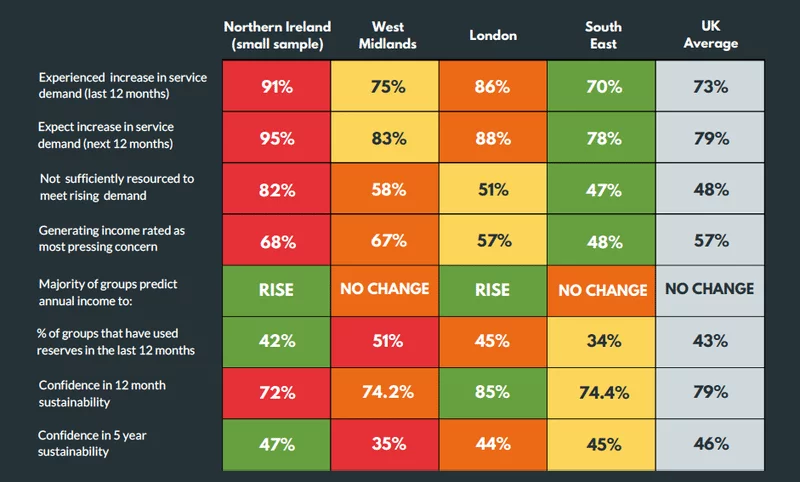Demand for services & funding difficulties top challenges for local charities, says LocalGiving report
Local charities are facing an ever-increasing demand for services coupled with greater difficulty in finding funding, according to LocalGiving’s Local Charity & Community Group Sustainability Report 2016.
73% of respondents reported an increase in demand for their services, while less than 2% reported a decrease, and 78% of groups predict further increases in demand over the coming year. Out of the groups predicting an increase in demand, 18% said they felt sufficiently resourced to meet this demand.
These concerns were most pronounced among charities with an annual turnover of between £501k and £1m, with 15% of these groups confident that they can cope with rising demands.
Short-term, local charities are largely optimistic about their survival, but less so over the longer term. 79% of respondents are confident that their organisation can sustain itself financially over the next 12 months. However, this drops to 46% when stretched over a five-year period.
While 12% saw themselves as having been at risk of closure over the last 12 months, a much greater percentage of 76% had reduced staff numbers, while 35% had seen a discontinuation in one or more of their services.
Biggest challenges
Generating income and achieving financial security was the biggest issue with 57% of groups seeing this as their most pressing issue over the coming 12 months. 76% of groups highlight “competition for grants and contracts” as a financial concern, with 65% seeing “generating donations from the general public” as a challenge.
43% of groups said they had dipped into their reserves in the last year, with 36% of groups citing building reserves as a financial concern. However, this is a decrease from 2015, when 43% cited it as a concern.
Income sources
Grants were the primary source of income for 50% of groups in the previous financial year, with 51% predicting grants to be their primary income source in the current financial year.
Behind grants and contracts, donations generate more income for local charities than any other channel. This is the case for both the previous and current financial year and overall, 79% of groups have received funding from the general public in the last 12 months, but 65% see difficulty in generating donations from the general public as a current financial concern.
Grants and donations are particularly important to micro-charities, with 52% identifying grants as their primary source of income, and 23% saying the same about donations: more than double that of larger groups.
Social investment provides a much smaller proportion of funds overall. 15% of respondents had even considered social investment as a funding source for their organisation; and more than half of respondents were unsure what social investment was. Groups with a medium to high annual income were more likely to have considered social investment than smaller groups. 40% of groups with an annual income of £501k – £1 million had considered social investment, compared to 9% of groups with an annual income of £0 – £50k.
Advertisement
Report recommendations
The report recommends a continued focus on diversifying income with increased exploration of new funding channels such as corporate partnerships, social investment and public donations. It also recommends that government, grant makers, voluntary sector organisations and work together to provide more accessible unrestricted funding opportunities for local charities.
Additional recommendations:
- Continued support for local charities to build fundraising capacity, to help them diversify their sources of income.
- Accessible and ongoing training opportunities, ideally including face-to-face support and the provision of help to retain staff and volunteers to avoid loss of skills later down the line.
- Funders should take responsibility for reducing inefficiencies in grant application processes to enable more time to be dedicated to service delivery.
John Barrett, chief executive of the Small Charities Coalition, said:
“This survey is an important benchmark of the sector, and reflects the wider picture we are seeing. It is clear that people are relying on small charities more than ever. But they are facing increasing financial pressures, with cuts to grants. To survive, it is crucial that they get support they need. Small charities are brilliant at innovation and having to think creatively with limited resources. For them to be able to collaborate they need the financial security to have the headspace to connect. We need to take action based on these findings.”
Ceri Edwards, director of policy and communications at the Institute of Fundraising also commented on the report, saying:
“This report is a timely reminder of the challenges that smaller charities face in securing support for the essential work they do for the wellbeing of local communities. It’s no surprise that many smaller charities are struggling in the current funding environment, but with demand for their services ever-increasing it’s crucial that they find new ways to raise money to deliver these services.”
The report was released to coincide with last week’s Local Charities Day (16th December). LocalGiving has also announced that over £23,000 was raised for 200 local charities on Local Charities Day through its #GiveMe5 campaign, which saw it double 1,000 £5 donations made to them on the day.




